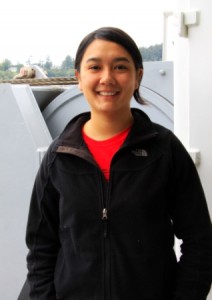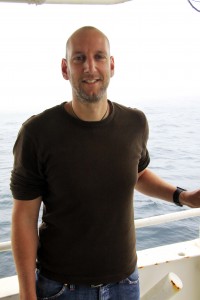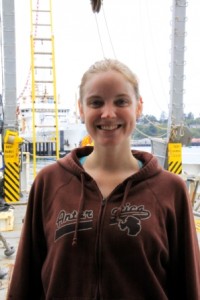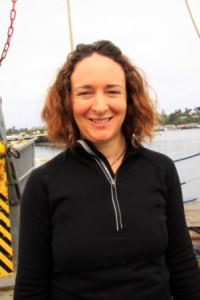Hello! I’m a PhD candidate in Mechanical Engineering through the MIT/WHOI Joint Program. My research interest is in biomimetics as a tool for improving underwater technology, especially through the study of the underlying fluid mechanics. For this cruise, I’ve built a first prototype of a flow sensor that is inspired by seal whiskers and will be testing it in the ocean for the first time!
I am an Assistant Professor in the Biology Department at the University of Miami. Research in my lab is focused broadly on the relationships between genotype and phenotype from both developmental and evolutionary perspectives and uses marine invertebrates as models. On this expedition I will be collecting hyperiid amphipods, a morphologically diverse group of pelagic crustaceans, from midwater net trawls. Interestingly the morphological disparity between hyperiids often manifests in spectacular modifications to the eyes and chemosensory systems. The specimens I am collecting on this expedition will be used for a number of molecular genetic, genomic, and microscopy experiments in my lab aimed at better understanding the influence of the pelagic midwater environment on the development of these divergent structures and the evolution of hyperiid lineages.
I am a graduate student at Northwestern University and am interested in biogeochemical cycles; specifically the transport, transformation, and burial of organic carbon. Active margins, such as Cascadia, are characterized by high sediment transport rates and a close proximity between terrestrial sediment source and marine burial. These factors allow active margins to be particularly efficient in the burial of organic carbon, resulting in high fidelity records of the terrestrial and marine environment spanning millions of years. Differences through time in the quantity and type of exported organic carbon from terrestrial environments can provide information on past storm frequency, sea level, precipitation regimes, vegetation type, erosion rate, and tectonic uplift.
I am a cruise mentor. I am an organic geochemist and a faculty member at the Bermuda Institute of Ocean Sciences (BIOS). I am the Principal Investigator of the three decade long Oceanic Flux Program (OFP) sediment trap time-series off Bermuda, one of the longest running time-series in oceanography. A primary research objective is to understand how temporal patterns in deep ocean flux magnitude and composition are linked with upper ocean physical and biological variability and how particle flux material is modified by biological and chemical processing within the water column. On the cruise, my main roles are to provide training in seagoing skills, especially those needed to be an effective chief scientist, and to assist cruise participants as needed.
I am an Assistant Professor of Marine Biology at University of Alaska, Fairbanks, and one of the two co-chief scientists for this cruise. My research focuses on the biology and ecology of benthic invertebrates, particularly in polar and deep-sea environments. On this expedition, I am working with Craig McClain to see if benthic biodiversity in the Astoria Canyon is enhanced due to the presences of extra food. Canyons are known to have focusing effects on sinking food particles that sustain benthos, which helps to support more organisms than on comparable continental slope habitats.
After obtaining my PhD from the University of Groningen, the Netherlands, I am now a postdoctoral fellow at the Monterey Bay Aquarium Research Institute, Moss Landing. My research focuses on life history strategies of meso- and bathypelagic invertebrates, in particular squid. In my postdoc I aim to test the hypothesis that midwater invertebrates grow slower and live longer than their shallow water relatives, a trend present for benthic deep-sea fish, bivalves and corals. For midwater invertebrates hardly any data on size-at-age exist. For the collection of animals I make use of Remotely Operated Vehicles and midwater trawls. During the cruise I aim to collect squid for which we have verified daily increment deposition in their statoliths, calcium carbonate structures in the organs of balance. By quantifying the number of increments in statoliths, size-at-age (in days) can be estimated and growth curves can be reconstructed. Mesopelagic and bathypelagic squid are very important in the oceanic food web as many fish including commercial species fish like tuna, swordfish and sharks feed heavily on them. Size-at-age and growth rates of deep-sea squid are indispensable for our understanding of ocean productivity and with that stock assessment and ecosystem based fisheries management.
I am a Postdoctoral Associate and paleobiologist in the Department of Geology and Geophysics at Yale University. I research the evolution of open ocean organisms and their ecosystems over long time scales using the tiny fossils of planktonic foraminifera. Planktonic foraminifera are protists (i.e., single celled eukaryotes) that make beautiful shells out of calcium carbonate. These shells trap geochemical information about the environment and life history of individuals, making planktonic foraminifera a fantastic group for studying the evolution of oceans and their inhabitants. On this cruise I am hoping to catch and study the ecology and geochemistry of deep dwelling living planktonic foraminifera along with their fellow zooplankton.
I am a biologist and a postdoc at Woods Hole Oceanographic Institution who is interested in the ecophysiology of zooplankton. My work investigates how anthropogenic changes to the global climate impact zooplankton distribution and physiology. Aboard this cruise I will be collecting pteropods, a group of fascinating and beautiful pelagic marine snails, to examine their response to CO2. These particular animals are interesting because they are an important prey species for commercial fish and, because of their delicate aragonite shells, they may be very susceptible to ocean acidification (decreasing ocean pH as
a result of human production of CO2).
I am the Assistant Director of Science for the National Evolutionary Synthesis Center and am interested in the ecological and evolutionary drivers of marine invertebrate biodiversity and body size. I focus primarily on deep-sea systems often looking at the consequences of food limitation on biological systems. I am also an author and editor of Deep-Sea News, a popular deep-sea themed blog, and write regularly for Cosmos, American Scientist, and Wired. Submarine canyons are a prevalent feature of the world’s oceans but remain relatively unexplored. Interestingly, these geological features may possess a great wealth of biodiversity. On this expedition I will be exploring the potential for this heightened biodiversity and the how it emerges.
I am an assistant professor in the College of Oceanic and Atmospheric Sciences (COAS) at Oregon State University where my primary job is management of the stable isotope laboratory. My research involves the use of stable isotopes and redox-sensitive trace metals to answer question about how the ocean has changed over time (i.e., paleoceanography). On this research cruise my objectives are two-fold. First, I am collecting water samples for carbon and oxygen isotopic analysis. These data will be used by other researchers to determine the depth at which certain organisms make their carbonate “shells”. Second, I am collecting settling marine particles, known as “marine snow”, to look for the presence of sulfate reducing bacteria that maybe involved in the scavenging of redox-sensitive trace metals such as molybdenum and silver from the water column.
I am a senior faculty research assistant / coring technician at Oregon State University responsible for collecting seafloor sediment samples. During this cruise, sediment will be sampled using a multicorer (which takes eight separate - 4 inch diameter surface samples at once), a box corer (which takes a 20cm x 30cm surficial benthic sample) and lastly a 4 inch diameter gravity corer that takes samples up to ten feet long. The other biographies describe all the wonderful things that will happen to these seafloor sediment samples. Never a dull moment !
I am a research zoologist at the Smithsonian National Museum of Natural History interested in evolution of pelagic invertebrates. I explore the deep water column (the midwater or ocean water below the sea’s surface and above the deep-sea floor, which is largest habitat on earth by volume) to study various invertebrates. Most pelagic invertebrates have very different morphology, behavior and ecology than their closest bottom-dwelling relatives making me wonder why the dramatic differences. I study their morphology, evolutionary history (based on molecular genetics), behavior and ecology to answer questions about how this unique habitat has shaped the animals into what we find today. As a participant in this cruise, I am leading the midwater trawling efforts and am hoping to collect munnopsid isopods, ribbon worms, tomopterids (transparent, bioluminescent, segmented worms), green bomber worms (Swima), and anything else unusual that turns up in our nets.
I am a graduate student in Ocean Sciences at UC Santa Cruz and work in the bioluminescence lab at the Monterey Bay Aquarium Research Institute. My research is focused on understanding the molecular biology and evolution of genes responsible for bioluminescence in a wide variety of marine taxa. On this cruise I’m interested in collecting different groups of bioluminescent cephalopods that inhabit the mesopelagic zone. Cephalopods are of particular interest because they appear to have evolved the ability to produce light differently within closely related groups.
This chief scientist training cruise is funded by the National Science Foundation and I am the Principal Investigator. I serve the UNOLS community as chair of the Fleet Improvement Committee and this is where the idea for these cruises originated. On this cruise I am acting as a mentor, working to engage the participants in all aspects of cruise planning, execution and reporting. I have been going to sea since I was an undergraduate–some 35 years. My own science expertise is sediment biogeochemistry, but it is a treat to lend a hand in the multi-disciplinary projects of this cruise. My academic home is Oregon State University where I am a Professor in the College of Oceanic and Atmospheric Sciences.
I am a biologist and oceanographer at the University of South Florida – College of Marine Science working towards my doctorate degree. My research explores methods of utilizing pteropods (pelagic marine snails) as bioindicators of environmental change, which includes topics in ecophysiology and biogeography. I am collecting pteropods on this cruise to examine how ocean chemistry is related to shell calcification depths.
I study ocean currents, their strength, their fluctuations, and how they contribute to ocean currents and earth’s climate. I’m currently a postdoc at the Max Planck Institute for Meteorology in Hamburg, Germany, where I work with a joint US-UK project that measures the strength of the global overturning circulation in the North Atlantic (at 26N). With daily measurements since 2004, we obtain a baseline description of overturning circulation and can relate it to slow changes related to climate change. While on the Wecoma, I am switching gears to study how currents that flow along the Oregon shelf interact with Astoria canyon. If nutrients are raised from the deep water by upwelling or mixing within submarine canyons, then that can support a large biomass in the canyon.
I am a postdoc in ocean physics at the Applied Physics Laboratory at the University of Washington. I am interested in internal waves and mixing near topography. On this cruise I will be doing a CTD time series with accompanying ADCP measurements to investigate the internal waves in Astoria Canyon, estimate energy fluxes up the canyon, and look at the time variability of turbulence during the semidiurnal tidal cycle.

















